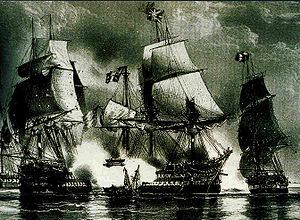French ship Ça Ira (1768)
 Ça Ira fighting on 14 March 1795 | |
| Career (France) | |
|---|---|
| Name: | Ça-Ira |
| Builder: | Arsenal of Brest |
| Laid down: | August 1766 |
| Launched: | May 1768 |
| Christened: | 1768 as La Couronne |
| Renamed: | Renamed Ça-Ira in 1792 |
| Reclassified: | rebuilt in 1784 in Toulon |
| Captured: | Captured by the Royal Navy on 14 March 1795 |
| General characteristics | |
| Class and type: | Saint-Esprit class ship of the line |
| Displacement: | 1754 tonnes |
| Length: | 59.8 metres |
| Beam: | 14.9 metres |
| Draught: | 7.5 metres |
| Complement: | 970 |
| Armament: |
80 guns:
|
The Couronne was a 80-gun ship of the line of the French Navy.
Contents
Career
American revolutionary war
She took part in the Battle of Martinique under Guichen.
She had a refit at Toulon in 1784[1].
French Revolution
In 1792 she was renamed Ça Ira, in reference to the revolutionary anthem Ah! ça ira.
On 14 March 1795, she took part in the Battle of Genoa, in which a French squadron, under Admiral Martin, was pursued by a superior British fleet. During the chase, around 9:00, Ça Ira ran afoul of Victoire, losing her fore and main topmasts and falling back of the French squadron. The frigate HMS Inconstant caught up and engaged Ça Ira; Vestale came to help, fired distant broadsides at Inconstant and took Ça Ira in tow[2]. Ça Ira began a heavy fire on Inconstant which forced her to retreat. At 10:45, HMS Agamemnon caught up and opened fire, shortly aided by HMS Captain; artillery duel continued for four hours until French ship came to support Ça Ira, compelling Agamemnon to retreat.
During the night, Vestale was relieved by the 74-gun Censeur in towing the now dismasted Ça Ira. In the morning, the British fleet had come in windward; HMS Captain caught up and engaged the two French ships, which battered her for 1 hour and 15 minutes, leaving her severely damaged, in distress, and eventually to be towed away from the action. HMS Bedford came to reinforce Captain, and had her rigging also severely damaged. The British fire had also reduced Ça Ira and Censeur to an almost helpless state. The main of the French fleet attempted to come to the rescue of her rear again and size the opportunity of the battered state of the British vanguard, but the lack of wind and opposition by HMS Illustrious and HMS Courageux prevented any effective action. As a favourable wind built up, the French squadron retreated, leaving Censeur and Ça Ira without hope of rescue. Reduced to hulks, the French ships eventually struck. They were taken into Spezia Bay.
Late career
Ça Ira was commissioned in the Royal Navy, but in too battered a state to serve, she was used as a hospital hulk in Saint Florent.
Ça Ira was destroyed in April 1796 in a fire; boats from other ships attempted to aid, but as the fire became out of control, Ça Ira was evacuated and brought away from the anchorage. She drifted and ran aground half a mile to the northward of the citadel and burnt to the water line. An inquiry subsequently concluded that the fire had been accidentally put on by a "bottle of combustible matter improperly kept in the carpenters cabin", and acquitted the officers from blame [3].
Archeological discovery
In 1988, a 19th century map was discovered, allowing the discovery of the wreck the next year, and its subsequent excavation. From 1990 to 1995, underwater archeological survey was undertaken by Tech Sub, a non-profit organisation.
Sources and references
- ↑ la fin du Ca-Ira, par Pierre Villié, directeur de fouille
- ↑ The Naval History of Great Britain, by William James, Frederick Chamier
- ↑ le Ca-Ira dans les archives anglaises
